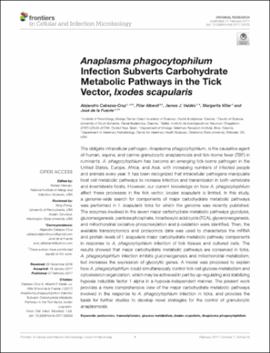| dc.contributor.author | Cabezas-Cruz, Alejandro | |
| dc.contributor.author | Alberdi, Pilar | |
| dc.contributor.author | Valdes, James J. | |
| dc.contributor.author | Villar, Margarita | |
| dc.contributor.author | Fuente, Jose de la | |
| dc.date.accessioned | 2019-08-28T16:00:53Z | |
| dc.date.available | 2019-08-28T16:00:53Z | |
| dc.date.issued | 2017-02-07 | |
| dc.identifier | oksd_cabezascruz_anaplasmaphago_2017 | |
| dc.identifier.citation | Cabezas-Cruz, A., Alberdi, P., Valdes, J. J., Villar, M., & Fuente, J. d. l. (2017). Anaplasma phagocytophilum infection subverts carbohydrate metabolic pathways in the tick vector, Ixodes scapularis. Frontiers in Cellular and Infection Microbiology, 7. https://doi.org/10.3389/fcimb.2017.00023 | |
| dc.identifier.uri | https://hdl.handle.net/11244/321385 | |
| dc.description.abstract | The obligate intracellular pathogen, Anaplasma phagocytophilum, is the causative agent of human, equine, and canine granulocytic anaplasmosis and tick-borne fever (TBF) in ruminants. A. phagocytophilum has become an emerging tick-borne pathogen in the United States, Europe, Africa, and Asia, with increasing numbers of infected people and animals every year. It has been recognized that intracellular pathogens manipulate host cell metabolic pathways to increase infection and transmission in both vertebrate and invertebrate hosts. However, our current knowledge on how A. phagocytophilum affect these processes in the tick vector, Ixodes scapularis is limited. In this study, a genome-wide search for components of major carbohydrate metabolic pathways was performed in I. scapularis ticks for which the genome was recently published. The enzymes involved in the seven major carbohydrate metabolic pathways glycolysis, gluconeogenesis, pentose phosphate, tricarboxylic acid cycle (TCA), glyceroneogenesis, and mitochondrial oxidative phosphorylation and β-oxidation were identified. Then, the available transcriptomics and proteomics data was used to characterize the mRNA and protein levels of I. scapularis major carbohydrate metabolic pathway components in response to A. phagocytophilum infection of tick tissues and cultured cells. The results showed that major carbohydrate metabolic pathways are conserved in ticks. A. phagocytophilum infection inhibits gluconeogenesis and mitochondrial metabolism, but increases the expression of glycolytic genes. A model was proposed to explain how A. phagocytophilum could simultaneously control tick cell glucose metabolism and cytoskeleton organization, which may be achieved in part by up-regulating and stabilizing hypoxia inducible factor 1 alpha in a hypoxia-independent manner. The present work provides a more comprehensive view of the major carbohydrate metabolic pathways involved in the response to A. phagocytophilum infection in ticks, and provides the basis for further studies to develop novel strategies for the control of granulocytic anaplasmosis. | |
| dc.format | application/pdf | |
| dc.language | en_US | |
| dc.publisher | Frontiers Media | |
| dc.rights | This material has been previously published. In the Oklahoma State University Library's institutional repository this version is made available through the open access principles and the terms of agreement/consent between the author(s) and the publisher. The permission policy on the use, reproduction or distribution of the material falls under fair use for educational, scholarship, and research purposes. Contact Digital Resources and Discovery Services at lib-dls@okstate.edu or 405-744-9161 for further information. | |
| dc.title | Anaplasma phagocytophilum infection subverts carbohydrate metabolic pathways in the tick vector, Ixodes scapularis | |
| osu.filename | oksd_cabezascruz_anaplasmaphago_2017.pdf | |
| dc.description.peerreview | Peer reviewed | |
| dc.identifier.doi | 10.3389/fcimb.2017.00023 | |
| dc.description.department | Veterinary Pathobiology | |
| dc.type.genre | Article | |
| dc.type.material | Text | |
| dc.subject.keywords | anaplasma phagocytophilum | |
| dc.subject.keywords | ixodes scapularis | |
| dc.subject.keywords | glucose metabolism | |
| dc.subject.keywords | proteomics | |
| dc.subject.keywords | transcriptomics | |
